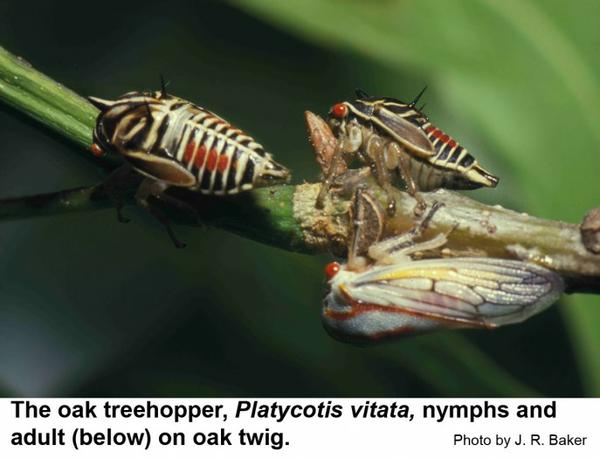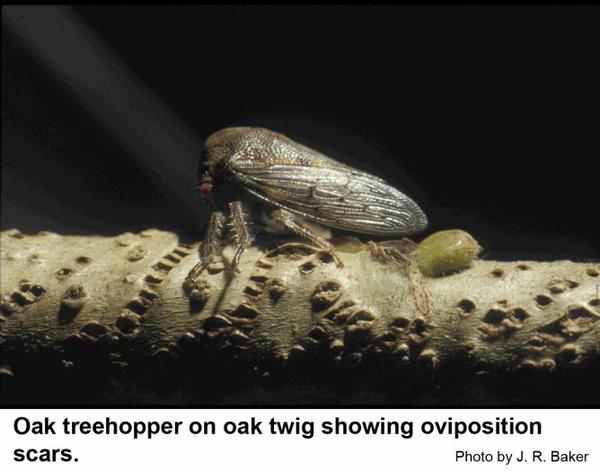Description and Biology
Oak treehoppers, Platycotis vittata, feed gregariously on oaks throughout the eastern United States. These insects are somewhat closely related to leafhoppers, but tend to be larger and to have the forward part of the thorax variously modified into bumps and spines. The oak treehopper is unusual in that young adults may be white with red and black markings whereas older adults are dull brown or dull green. Some specimens may have a conspicuous "horn" projecting from the thorax over the head. These insects court and mate in the morning or evening. Females mate more than once, but only the sperm of her last suitor is used to fertilize her 40 or so eggs. This insect overwinters as females in leaf litter. They emerge and lay their eggs the following spring. When the eggs hatch, the new nymphs gather around a slit in the bark made by the female. The Nymphs apparently feed at the slit and the female broods over them. Females definitely protect their nymphs by bumping predators. Second generation eggs are laid in August and these hatch and develop into the overwintering forms. Nymphs have two tiny "spikes" on their backs and they tend to be contrastingly marked with white, black, and red.
Host Plants
Oaks are the most frequently reported hosts of oak treehoppers, but they have been collected from river birch (Ohio) and chestnut (California).
Residential Recommendation
Oak treehoppers usually cause little damage to shade trees, but it is possible they may get out of hand. Most of contact pesticides, such as pyrethroids, Orthene, and others, should give more than adequate control of oak treehoppers. When used as directed, pyrethroids are very toxic to insects but are not particularly hazardous to humans and pets (other than fish-avoid using pyrethroids around pools, ponds, and streams).
References
- Common name: oak treehopper, scientific name: Platycotis vittata (Fabricius) (Insecta: Hemiptera: Membracidae). Mead, F. W. 2021 (reviewed). Featured Creatures, Entomol.& Nematol. FDACS/DPI, Univ. Florida. Pub. No. EENY-328.
- The beautiful and bizarre treehopper. Barrat, J. 2017. In Animals, Plants, Q & A, Research News, Science & Nature Smithsonian Insider.
- Extension Plant Pathology Publications and Factsheets
- Horticultural Science Publications
- North Carolina Agricultural Chemicals Manual
For assistance with a specific problem, contact your local N.C. Cooperative Extension center.
This Factsheet has not been peer reviewed.
Publication date: Dec. 11, 2013
Reviewed/Revised: Nov. 3, 2023
Recommendations for the use of agricultural chemicals are included in this publication as a convenience to the reader. The use of brand names and any mention or listing of commercial products or services in this publication does not imply endorsement by NC State University or N.C. A&T State University nor discrimination against similar products or services not mentioned. Individuals who use agricultural chemicals are responsible for ensuring that the intended use complies with current regulations and conforms to the product label. Be sure to obtain current information about usage regulations and examine a current product label before applying any chemical. For assistance, contact your local N.C. Cooperative Extension county center.
N.C. Cooperative Extension prohibits discrimination and harassment regardless of age, color, disability, family and marital status, gender identity, national origin, political beliefs, race, religion, sex (including pregnancy), sexual orientation and veteran status.


